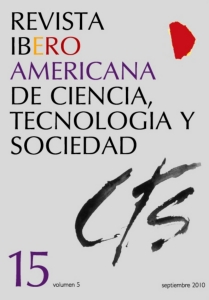Technical Function and Normativity
On Some Conceptual Difficulties of the Searlean Model
DOI:
https://doi.org/10.52712/issn.1850-0013-831Keywords:
artefact, technical function, Searle, normativityAbstract
This paper critically explores the thesis exposed in John Searle’s The Construction of Social Reality about functional attribution, in order to determine some of his limitations in its application to scope of technical artefacts and their functionality. In order to clarify that problem, this article is divided into two parts. The first one offers a reconstruction of Searlean vocabulary and its emphasis in normativity. In the second part, some delicate elements of Searle’s theory are discussed and an alternative approach to function in technical objects is suggested.
Downloads
References
BAKER, L. (2004): “The ontology of artefacts”, Philosophical Explorations, n. 7, pp. 99-111.
DENNETT, D. (1990): “The Interpretation of Texts, People and Other Artifacts”, Philosophy and Phenomenological Research, n. 50, pp. 177-194.
DIPERT, R. (1993): Artifacts, Arts Works, and Agency, Filadelfia, Temple University Press.
DIPERT, R. (1995): “Some issues in the Theory of Artifacts: Defining ‘Artifact’ and Related Notions”, The Monist, n. 78, pp. 119-35.
FRANSSEN, M. (2006): “The normativity of artefacts”, Studies in History and Philosophy of Science, n. 37, pp. 42-57.
HEIDEGGER, M. (1983): Die Grundbegriffe der Metaphysik, Frankfurt Am Main, Klostermann.
HOUKES, W. y VERMAAS, P. (2004): “Actions versus functions: a plea for an alternative metaphysics of artefacts”, The Monist, (87), pp. 52-71.
HOUKES, W. (2006): “Knowledge of artefact functions”, Studies in History and Philosophy of Science, n. 37, pp. 102-113.
HOUKES, W., VERMAAS, P., DORST, K. y DE VRIES, M. (2002): “Design and use as plans: an action-theoretical account”, Design studies, n. 23, pp. 303-320.
HUGHES, J. (2008): “An artifact is to use: an introduction to instrumental functions”, Synthese, n. 78, pp. 120-137.
HUND, J. (1998): “Searle’s Construction of Social Reality”, Philosophy of Social Sciences, n. 28, pp. 122-131.
KROES, P. (2001): “Technical Functions as dispositions: A Critical Assessment”, Techné, vol. 3, n. 5, pp. 1-16.
KROES, P. (2003): “Screwdriver philosophy: Searle’s analysis of technical functions”, Techné, vol. 3, n. 6, pp. 22-35.
LAWLER, D. (2008): “Una aproximación exploratoria a nuestro lenguaje normativo sobre los artefactos técnicos”, Revista CTS, vol. 4, n. 10, pp. 19-31.
LEROI-GOURHAN, A. (1989): El medio y la técnica. Evolución y técnica II, Madrid, Taurus.
LUKES, S. (2006): “Searle and his critics”, Anthropological theory, vol. 6, n. 1, pp. 5-11.
PARENTE, D. (2008): “Artefactos y textos. Algunas aporías en la hermenéutica artefactual de Dennett”, Scientiae Studia, vol. 3, n. 6, pp. 345-358.
PRESTON, B. (1998): “Why is a wing like a spoon? A Pluralist Theory of Function”, The Journal of Philosophy, XCV, n. 5, pp. 215-254.
SCHEELE, M. (2007): “Social Norms in Artefact Use: proper functions and action theory”, Techné, n. 10, pp. 60-70.
SEARLE, J. (1996a): “Précis of The Construction of Social Reality”, Philosophy and Phenomenological Research, (LVII), n. 2, pp. 427-428.
SEARLE, J. (1996b): “Responses to critics of The Construction of Social Reality”, Philosophy and Phenomenological Research, (LVII), n. 2, pp. 449-458.
SEARLE, J. (1997): La construcción de la realidad social, Barcelona, Paidós.
SEARLE, J. (2007): “Social ontology”, en E. Margolis y S. Laurence (eds.): Creations of the mind. Theories of artifacts and their representation, Nueva York, Oxford University Press.
VEGA, J. (2007): “La sustancialidad de los artefactos”, en D. Parente (ed.): Encrucijadas de la técnica. Ensayos sobre tecnología, sociedad y valores, La Plata, EDULP.
WETTERSTEN, J. (1998): “Symposium on Searle: The Analytical Study of Social Ontology”, Philosophy of Social Sciences, n. 28, pp. 132-151.
Downloads
Published
How to Cite
Issue
Section
License
Copyright (c) 2025 CC Attribution 4.0

This work is licensed under a Creative Commons Attribution 4.0 International License.
All CTS's issues and academic articles are under a CC-BY license.
Since 2007, CTS has provided open and free access to all its contents, including the complete archive of its quarterly edition and the different products presented in its electronic platform. This decision is based on the belief that offering free access to published materials helps to build a greater and better exchange of knowledge.
In turn, for the quarterly edition, CTS allows institutional and thematic repositories, as well as personal web pages, to self-archive articles in their post-print or editorial version, immediately after the publication of the final version of each issue and under the condition that a link to the original source will be incorporated into the self-archive.











